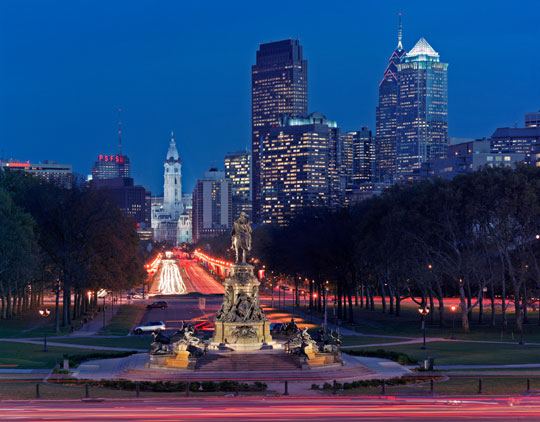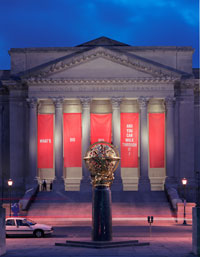 The Lighting Practice was responsible for the sculptural and environmental lighting of the Benjamin Franklin Parkway.In 1981, when now husband-and-wife Rob and Helen Diemer graduated from Pennsylvania State University with degrees in architectural engineering, they were entering an industry that wasn’t all that concerned with energy conservation. But about a decade ago, things started to change, and both paid attention to the murmurs about “green building.”
The Lighting Practice was responsible for the sculptural and environmental lighting of the Benjamin Franklin Parkway.In 1981, when now husband-and-wife Rob and Helen Diemer graduated from Pennsylvania State University with degrees in architectural engineering, they were entering an industry that wasn’t all that concerned with energy conservation. But about a decade ago, things started to change, and both paid attention to the murmurs about “green building.”
 Rob & Helen Diemer: Dynamic Duo“I decided to look into LEED and it excited me,” says Rob. “Twenty years into my career, I realized that I went to school to build a whole building, not one piece of it. I felt that moving my practice toward green building, sustainable design and energy conservation was my window of opportunity to help move my industry away from thinking of energy as an infinite resource, and to start thinking about it more holistically.”
Rob & Helen Diemer: Dynamic Duo“I decided to look into LEED and it excited me,” says Rob. “Twenty years into my career, I realized that I went to school to build a whole building, not one piece of it. I felt that moving my practice toward green building, sustainable design and energy conservation was my window of opportunity to help move my industry away from thinking of energy as an infinite resource, and to start thinking about it more holistically.”
As it turned out, Helen and Rob’s work in energy-efficient building and lighting would not only affect entire buildings, but entire cities — especially Philadelphia. In 2010, Rob became founding partner of In-Posse — Latin for “in potential.” It’s an apt name, as the consulting and engineering design service company pushes boundaries to actualize the highest performing, most sustainable buildings possible. In-Posse is a subsidiary of AKF Group, the engineering firm where Rob has worked since 1992 and is now a partner.
In their most recent attempt to push the envelope in green building, In-Posse is collaborating with AKF Group on a project to build two Net Zero Energy schools — in New York City and Cambridge, Massachusetts — serving as the project’s Net Zero Energy consultant, renewable energy system designer and energy modeling company. Net Zero Energy is a certification provided by the Living Building Challenge for buildings that harvest renewable energy in excess of their energy usage. “The school projects are exciting not only because we’re creating Net Zero Energy buildings,” says Rob, “but because of the potential to influence the understanding and outlook of energy in younger generations.”
In-Posse’s work is present in Philadelphia as well, including the Friends Center, one of the highest-scoring LEED projects in Pennsylvania, and the Community Legal Services building in North Philadelphia, which earned a LEED Gold designation. In-Posse is also assisting PECO in their efforts to achieve a LEED for Existing Buildings certification. As chair of DVGBC from 2005 to 2007, Rob also impacted the city by helping to start The Urban Sustainability Forum, now held monthly at The Academy of Natural Sciences at Drexel University.
 More of the Lighting Practice’s work at the Franklin InstituteHelen Diemer steered her career toward making Philadelphia’s public space brighter. She joined The Lighting Practice (TLP) in 1994 and became president in 2009. The company is largely responsible for the city’s embrace of lighting in its nighttime environment: the glimmer of the Avenue of the Arts, the romanticism of Fairmount Waterworks and the glow of City Hall are all thanks to the TLP team. As lighting designer for the Delaware River Trail, TLP is utilizing solar power lighting to eliminate the need for expensive underground wiring. Operating off the grid proved to be the most sustainable and economical solution.
More of the Lighting Practice’s work at the Franklin InstituteHelen Diemer steered her career toward making Philadelphia’s public space brighter. She joined The Lighting Practice (TLP) in 1994 and became president in 2009. The company is largely responsible for the city’s embrace of lighting in its nighttime environment: the glimmer of the Avenue of the Arts, the romanticism of Fairmount Waterworks and the glow of City Hall are all thanks to the TLP team. As lighting designer for the Delaware River Trail, TLP is utilizing solar power lighting to eliminate the need for expensive underground wiring. Operating off the grid proved to be the most sustainable and economical solution.
“Where we live and work has as much, or more, of an impact on energy use as the energy efficiency of our buildings and public spaces do,” says Rob. “Cities are inherently sustainable places, as they don’t promote suburban sprawl and significantly reduce energy used for transportation. Enhancing the quality of life in our cities entices more people to live in cities and reduce their overall environmental impact.”
The Diemers agree about the importance of aesthetics in public spaces, but still benefit from each others’ slightly differing points of view. “By the nature of what she does, Helen is very concerned about aesthetics, and because of what I do, I am very concerned about energy conservation,” says Rob. “We both know that there needs to be a balance but because I am less involved in aesthetics, I can sometimes seem to diminish its importance. Helen is quick to put me in my place by reminding me that an energy efficient world without beauty would not be a very appealing world.”
Helen agrees. “I would argue that the lighting of public spaces is necessary power usage… Providing a desirable nighttime environment — which includes great nighttime lighting — encourages people to walk and enjoy the amenities that the city has to offer, instead of getting in their cars to seek refuge in the suburbs. It is a misconception that providing this amenity is wasted energy.”
“Our perspectives are different,” says Helen, “but I think we have both learned from the other’s point of view… At TLP, we strive to use that energy as efficiently as possible to make beautiful places. That is part of our creative challenge.”
Even with the major impact the Diemers have had on how resources are consumed and conserved in Philadelphia and beyond, Rob sees the choices of energy users as more important. “Designers and architects don’t use energy; we just set the stage,” he says. “Until building designers figure out how to engage building users and provide them the guidance, tools and motivation to adjust their energy use, we won’t be able to deliver buildings that truly use less energy.”
To learn more about what the Diemers are working on, visit Rob at in-posse.com and Helen at thelightingpractice.com.
Story by Julianne Mesaric.






